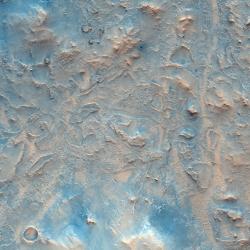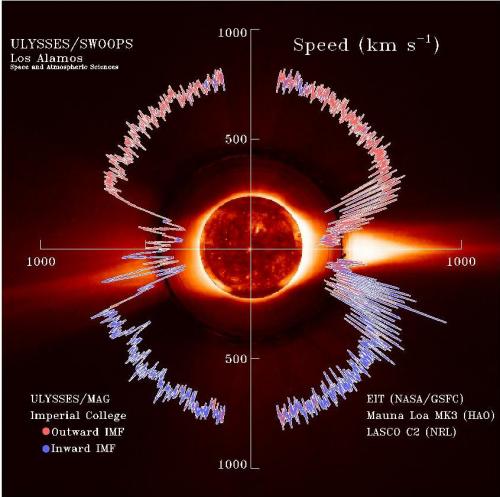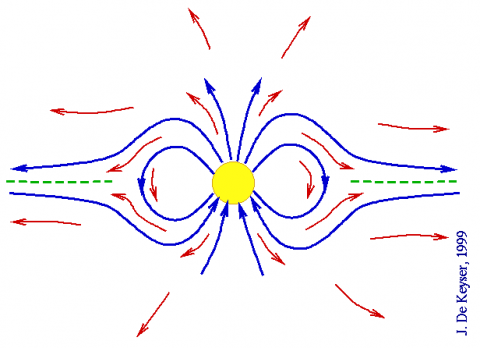Emissions at the poles or at the equator?
During the minimum of solar activity, a fast solar wind (on average 800 km/s) is expelled from the coronal holes (defined below), located mainly around the North and South poles of the Sun. This fast solar wind is relatively slightly variable.
In regions closer to the equator, the solar wind is more variable and slower, on average 400 km/s. One speaks of fast and slow solar wind.
At maximum solar activity, the solar wind is variable at all latitudes.
While escaping, the solar wind carries along the interplanetary magnetic field, illustrated in figure "The interplanetary magnetic field around the Sun" in case of weak activity.
Fast solar wind originates from coronal holes
The coronal holes are regions of the solar atmosphere where the lines of the magnetic field are open. Density and temperature are lower there than in other regions of the solar corona. The fast solar wind originates from these regions.
Relation to solar activity:
- During periods of low solar activity, there are only two coronal holes: one in the vicinity of each of the poles of the Sun. These coronal holes around the North and South poles are not necessarily symmetrical.
- In periods of strong solar activity, the coronal holes are irregular in shape and can appear at all latitudes, including the equatorial regions of the Sun.
Spiral structure like rotating garden sprinklers
The solar wind coming from the same point within the solar atmosphere is on one line having the shape of a spiral because of the rotation of the Sun: this line is also a magnetic field line.
This structure is called the Parker spiral. We can make the analogy with rotating garden sprinklers. Water is projected radially from the sprinklers but the shape of the water jets is a spiral.
Collision zone where fast solar wind catches up with slower wind
The contact area between the solar wind coming from the northern and the southern poles of the Sun is the heliospheric current sheet (HCS).
There where fast solar wind catches up with slower wind that was emitted earlier, a collision zone or shock front is produced. As slow wind is connected to the HCS, we only find such collision zones near the HCS. The fast solar wind pushes the slow wind and compresses it.
The structure of the solar wind can therefore be very irregular near the HCS. This kind of collision region generally arises only after a while, mostly when the solar wind passed the Earth's orbit.
Since the streams with fast and slow wind can last for months, one can follow these collision regions during successive solar rotations. Therefore one speaks of "corotating interaction regions".






